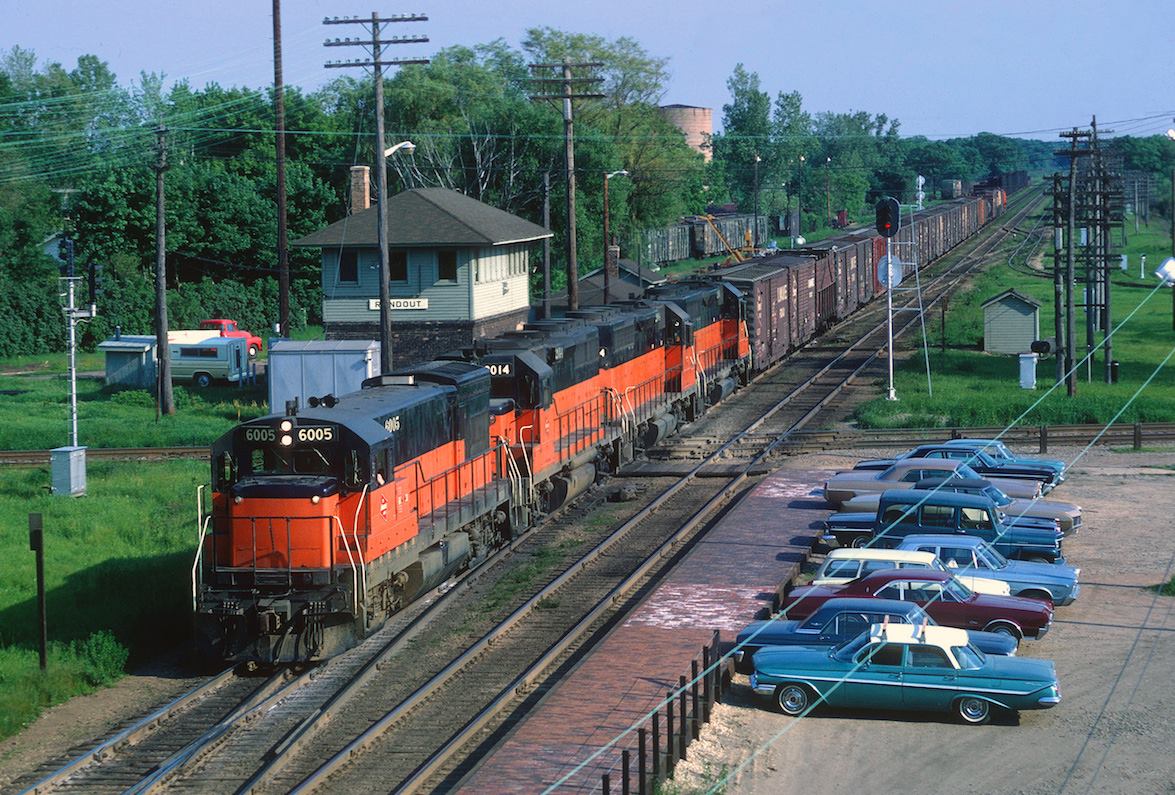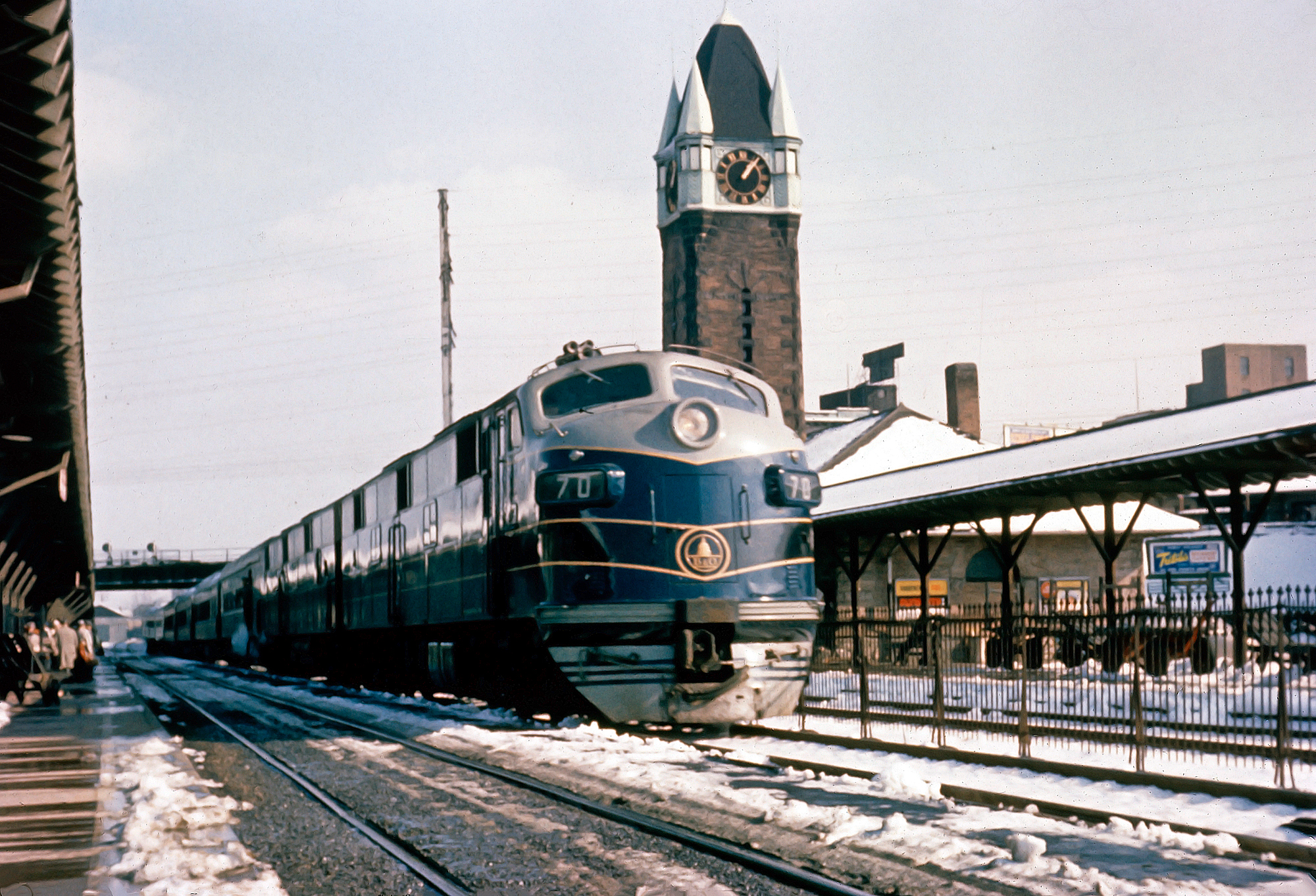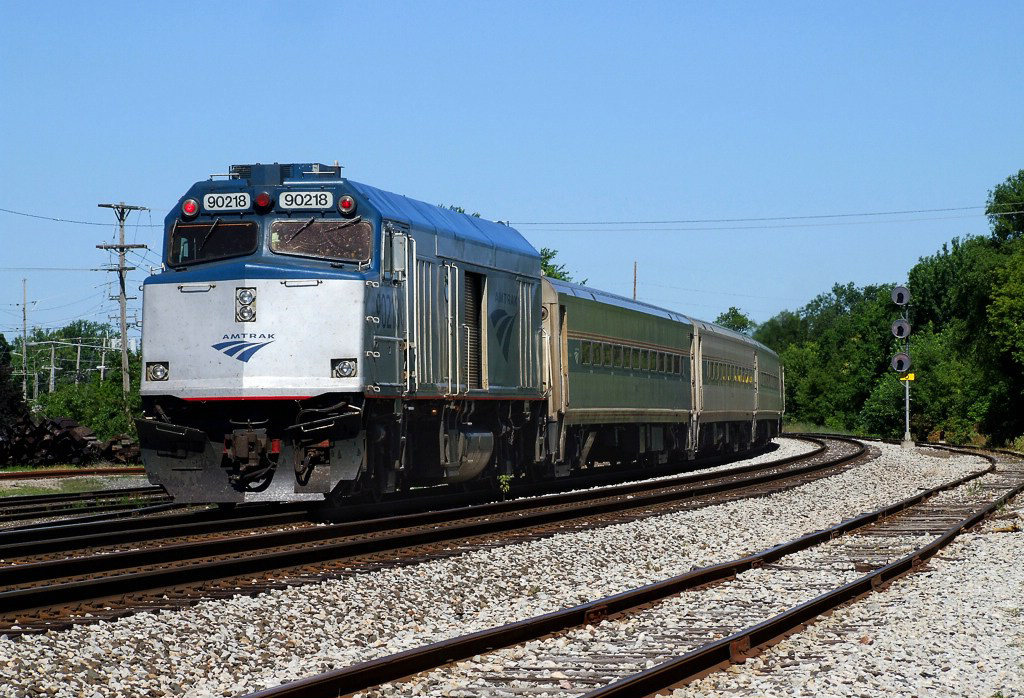The Railroad Diamond: Intersection of Steel and Precision
Published: July 23, 2024
By: Adam Burns
Railroads, the arteries of industrial and economic growth, rely on intricate engineering to ensure the smooth and reliable transportation of goods and passengers.
Among the impressive feats of railroad ingenuity is the diamond crossing. This fascinating and complex railway feature allows two tracks to intersect at grade.
While seemingly straightforward, the diamond serves a critical purpose and presents significant maintenance challenges. This article briefly explores the intricacies of this unique railroading feature, its purpose, and the efforts required to keep it operational.
 Milwaukee Road U28B #6005 and a trio of Electro-Motive units lead a short freight through the busy interlocking at Rondout, Illinois on June 14, 1968. David Hawkins collection.
Milwaukee Road U28B #6005 and a trio of Electro-Motive units lead a short freight through the busy interlocking at Rondout, Illinois on June 14, 1968. David Hawkins collection.Purpose
Intersection and Flexibility
At its core, the diamond enables two railway lines to cross each other at the same level or grade. The most apparent purpose of a diamond is to allow trains traveling on intersecting routes to pass through the junction efficiently without requiring grade separation, such as overpasses or underpasses.
In the early days of railroading, constructing entire networks meant crossing paths with other railroads frequently. Railroads evolved to accommodate intersecting routes without disrupting the flow of rail traffic.
While they are generally loathed due to their maintenance difficulty, the diamond ensures multiple rail lines can coexist and intersect seamlessly, granting railroads immense flexibility in route planning and connectivity.
Cost-Effectiveness
Constructing elevated or subterranean crossings is often prohibitively expensive and can be impractical in certain landscapes or densely populated areas.
Diamonds offer a cost-effective solution to intersection challenges by minimizing the need for extensive earthworks and structural engineering. This economic advantage was crucial during the rapid expansion of railroads across the United States in the 19th and early 20th centuries.
Technical Aspects
Design and Structure
The design of the diamond is deceptively simple. The name "diamond" derives from the diamond-like shape formed at the intersection when viewed from above.
Each of the intersecting tracks is cut to allow the passage of wheels from the opposing track, creating four rail gaps at the intersection. Specially shaped frog sections—a term used to describe the crossing point where two rails intersect—guide train wheels across these gaps without derailing.
Historically, diamonds were protected by interlocking towers under the watchful guide of an operator to ensure operations remained smooth and relatively safe.
At complex interlockings some of these structures remained in use well into the 2000s although in the modern era most have since been closed and can now be monitored by remote dispatching centers.
Types
Diamond crossings can be categorized based on the angle at which the tracks intersect:
- **Right-Angle Crossings**: Tracks intersect at a 90-degree angle. This type is common in urban environments and locations with perpendicular rail routes.
- **Acute-Angle Crossings**: Tracks intersect at angles less than 90 degrees, typically found where railways cross at oblique angles.
Mechanical Components
To traverse the crossings smoothly, diamond crossings include several unique components:
- **Frogs**: Special track segments that permit wheel flanges to pass through gaps without obstruction.
- **Guard Rails**: Additional rails positioned alongside the main rails to guide wheels and ensure smooth transitions across the frogs.
- **Switching Devices**: In high-traffic areas, diamonds may incorporate switch mechanisms to direct train paths and minimize the impact of potential collisions at the crossing.
Maintenance Challenges
The apparent simplicity of diamond crossings hides the extensive maintenance requirements needed to keep them in operation. The precision engineering involved in these intersections means that any deviation or misalignment can cause significant operational disruptions.
Wear and Tear
One of the primary challenges in maintaining diamond crossings is dealing with constant wear and tear. Every time a train passes over the crossing, the frog sections, guard rails, and adjacent tracks endure immense stress and force. This continuous mechanical load leads to material fatigue, wear, and eventual deformation.
Alignment Precision
Maintaining precise alignment and track gauge—a measure of the distance between the inside edges of the rails—is crucial for safe operation. Misaligned components can cause train wheels to derail, leading to costly repairs and potentially hazardous situations. Small deviations in alignment must be corrected promptly.
Inspection and Monitoring
Diamonds require frequent inspection and monitoring to detect early signs of wear and misalignment. This process involves using specialized equipment to measure rail profiles, frog conditions, and alignment accuracy.
Modern technologies such as ultrasonic testing, laser measurement, and acoustic monitoring aid maintenance crews in assessing the condition of diamond crossings.
Environmental Factors
Environmental conditions also play a significant role in the maintenance of diamond crossings. Temperature fluctuations, moisture, and debris accumulation can exacerbate wear and lead to structural degradation. Snow and ice in cold climates can pose additional challenges, necessitating de-icing and snow removal efforts to maintain operational integrity.
Scheduling and Operational Disruptions
Performing maintenance on diamond crossings often necessitates temporary track closures or operational restrictions. Coordinating these activities while minimizing disruption to rail services requires meticulous planning and effective communication between maintenance crews and rail operators.
Advances in Maintenance and Technology
Modern Materials and Designs
Advancements in materials science and engineering have led to the development of more resilient materials for diamond crossings. High-strength alloys, hardened steel, and composite materials enhance the durability and lifespan of key components. These innovations reduce the frequency of maintenance interventions and improve the overall reliability of the crossings.
Real-Time Monitoring
Real-time monitoring technologies are being integrated into diamond crossings to provide continuous feedback on their condition.
Sensors embedded within the crossing can measure parameters such as strain, vibration, and temperature. This data is transmitted to a central monitoring system, allowing maintenance teams to respond promptly to any anomalies.
Conclusion
The diamond stands as a testament to the ingenuity and complexity of railway engineering. Designed to facilitate the intersection of rail lines efficiently and cost-effectively, diamond crossings play a crucial role in maintaining the flexibility and connectivity of railroad networks. However, their maintenance poses significant challenges, from wear and tear to alignment precision.
Advances in materials science, automated inspection systems, and real-time monitoring have significantly improved the maintenance process, ensuring that diamonds remain operational and safe.
These innovations underscore the continued evolution of railroad technology, preserving the legacy of these critical intersections while adapting to the demands of modern rail transportation.
In the ever-evolving landscape of railroads, the diamond remains an enduring symbol of the intricate balance between engineering prowess and operational efficiency, bridging intersections of steel with precision and resilience.
Recent Articles
-
Guide To Amtrak/Passenger Trains In New Jersey
Apr 10, 25 09:40 PM
This guide highlights passenger train services currently available throughout the state of New Jersey. -
Rio Grande 4-6-6-4 Locomotives: Specs, Roster, Photos
Apr 10, 25 12:47 PM
The Rio Grande owned some large wheel arrangements, including the 4-6-6-4s. Interestingly, the railroad was never satisfied with these engines. -
Guide To Amtrak/Passenger Trains In Michigan
Apr 10, 25 12:06 PM
Michigan offers a variety of passenger train services, allowing travelers to discover the state's beauty and charm in a relaxed and comfortable manner. Learn more here.


